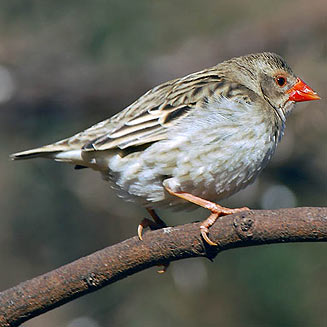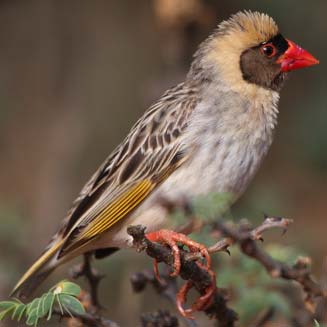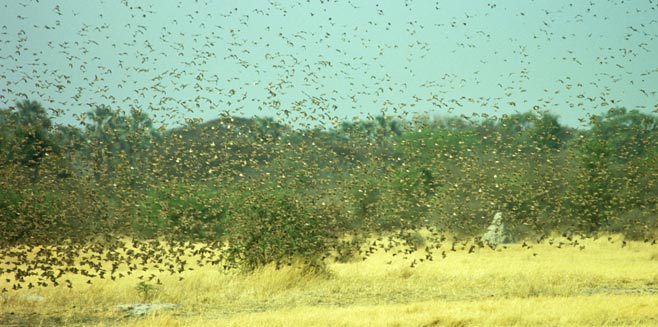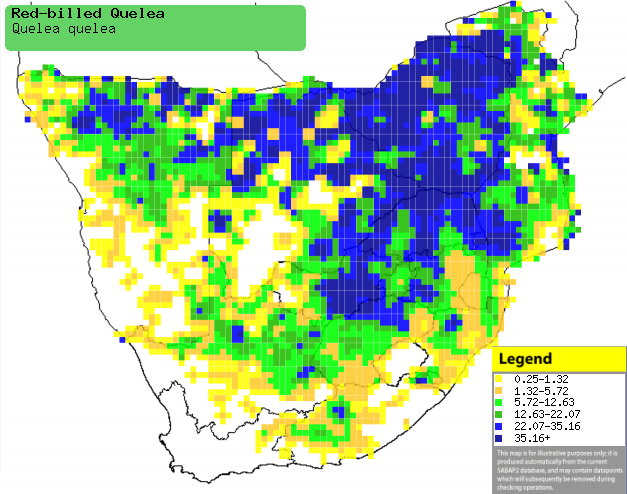|
Quelea quelea (Red-billed
quelea)
Rooibekkwelea [Afrikaans]; Enzunge (applied to some of the
bishops, widows and sparrows) [Kwangali]; Thaha (generic term for bishops
and queleas) [South Sotho]; Lerwerwe [North Sotho]; Chimokoto [Shona];
Inyonyane [Swazi]; Ndzheyana (generic term for weaver or quelea) [Tsonga];
Roodbekwever [Dutch]; Travailleur à bec rouge [French]; Blutschnabelweber
[German]; Quelea-de-bico-vermelho [Portuguese]
Life
> Eukaryotes >
Opisthokonta
> Metazoa (animals) >
Bilateria >
Deuterostomia > Chordata >
Craniata > Vertebrata (vertebrates) > Gnathostomata (jawed
vertebrates) > Teleostomi (teleost fish) > Osteichthyes (bony fish) > Class:
Sarcopterygii (lobe-finned
fish) > Stegocephalia (terrestrial
vertebrates) > Tetrapoda
(four-legged vertebrates) > Reptiliomorpha > Amniota >
Reptilia (reptiles) >
Romeriida > Diapsida > Archosauromorpha > Archosauria >
Dinosauria
(dinosaurs) > Saurischia > Theropoda (bipedal predatory dinosaurs) >
Coelurosauria > Maniraptora > Aves
(birds) >
Order: Passeriformes > Family: Ploceidae
> Genus: Quelea
 |
 |
|
Red-billed quelea female in non-breeding plumage. [photo
Callie de Wet ©] |
Red-billed quelea male in breeding plumage, Mokala
National Park, South Africa. [photo
Duncan Robertson
©] |
 |
|
Massive Red-billed quelea flock. [photo
Peter Steyn ©] |
Distribution and habitat
It is the most abundant wild bird on the planet, with an
estimated population of 1.5 billion birds, occurring across much of sub-Saharan
Africa, excluding the lowland forests of West Africa, arid areas of southern
Namibia, south-western Botswana and the southern half of South Africa. It is
most prolific in semi-arid habitats such as thornveld and cultivated land, but
it may also occupy exceptionally wet or dry areas.
|
 |
|
Distribution of Red-billed weaver in southern Africa,
based on statistical smoothing of the records from first SA Bird Atlas
Project (©
Animal Demography unit, University of
Cape Town; smoothing by Birgit Erni and Francesca Little). Colours range
from dark blue (most common) through to yellow (least common).
See here for the latest distribution
from the SABAP2. |
Predators and parasites
At different stages of development it has been recorded as
prey of the following animals:
- Adults (including those taken while drinking at waterholes)
- Chicks and fledglings
Movements and migrations
Nomadic, moving across large and short
distances in search of rainfall and the abundance of food which
follows.
Food
It mainly eats seeds of cereals and grasses, supplemented
with arthropods taken from vegetation and in flight. It is highly gregarious,
living in flocks which can be have millions of birds, which can completely
devastate cultivate areas. The following food items have been recorded in its
diet:
- Seeds
- indigenous grasses
- cereals
- maize
- sorghum
- manna
- millet
- oats
- buckwheat
- rice
- wheat
- Arthropods
Breeding
- Monogamous and highly colonial, breeding in highly synchronised colonies
which can be several kilometres in diameter! It is territorial, but the male
and female only defend the immediate vicinity of their nest.
- The nest is built solely by the male in about 2-3 days, consisting of a
small oval grass ball with a side-top entrance covered by a small hood. It
is typically attached to a thorny tree along with many other nests made by
other males.
- Egg-laying season is from December-March.
- It lays 1-5 eggs, which are incubated mainly by the female for about
10-12 days, while the male occasionally takes a short shift in the daytime.
- The chicks leave the nest after about 10-13 days, becoming fully
independent about 10-11 days later.
Threats
Not threatened, in fact it is so abundant and such a pest
that millions of birds are culled annually using explosives at roost sites and
aerial spraying, but even that doesn't have any long term affect on its
population.
References
-
Hockey PAR, Dean WRJ and Ryan PG 2005. Roberts
- Birds of southern Africa, VIIth ed. The Trustees of the John Voelcker
Bird Book Fund, Cape Town.
|
